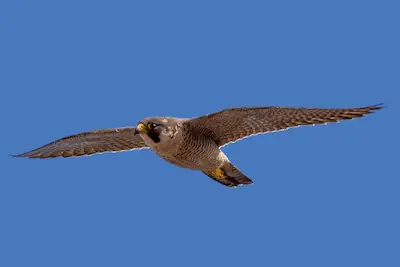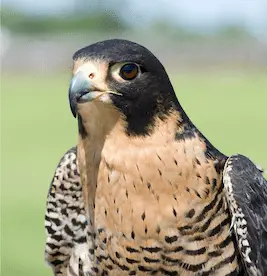Barbary Falcon
(Falco Pelegrinoides)
The Barbary Falcon looks very similar to its close relative, the Peregrine Falcon, and just like the Peregrine it also hunts birds with similar levels of aerial hunting skills that involve stooping down on prey at very high speeds.

Barbary Falcons breed in the desert areas of North Africa, the Middle East, and Central Asia, and within Europe they have a breeding population in the Canary Islands.
Unfortunately, Barbary Falcons are not very well studied, which makes it difficult to assess their conservation status, and to determine what needs to be done to ensure they continue to have a stable population.
Barbary Falcon facts
As a close cousin of the Peregrine Falcon, the Barbary Falcon resembles a Peregrine both in appearance and behavior. Below are the key facts on the Barbary Falcon:
Barbary Falcon size
The Barbary Falcon is a relatively large falcon species (although on average it’s 10% smaller than Peregrine Falcons), and has the following size measurements:
- Wingspan: 80-100 cm
- Length: 33-40 cm
- Weight: 550-720 g (females), 350-480 g (males)
Males and females significantly differ in size from each other, to the extent that their size measurements basically don’t overlap at all.
Appearance of Barbary Falcon vs Peregrine
The Barbary Falcon looks very similar to the Peregrine Falcon, but is quite a bit smaller than the Peregrine, with a wing spread that rarely reaches 100 cm. In terms of proportions, it has a very similar body structure to the Peregrine, with long pointed wings, and a short, stout tail.

Sexual dimorphism
Similar to most European raptors, female barbary falcons are larger than males, but otherwise there is no clear difference between the sexes.
Lifespan
The barbary falcon can reach up to 20 years of age, though it rarely achieves this age in the wild.
Scientific name and taxonomy
The scientific name of the Barbary Falcon is Falco Pelegrinoides. Considered to be a subspecies of the Peregrine Falcon in the past, the barbary falcon is now treated as a distinct species by most ornithologists.
Barbary falcon distribution
The main breeding distribution of the Barbary Falcon is in North Africa and the Middle East, with the largest population of Barbary birds found in Central Asian countries. It breeds in the eastern part of Turkey, as well as in La Palma, Canary Islands.
Barbary Falcon habitat
The Barbary Falcon mostly inhabits deserts, arid and semi-arid zones, but can also be found on the coast. In general, it can be found in locations where it can find its main forage species, which include sandgrouse and pigeons. In addition to requiring a sufficiently rich food source, Barbary Falcons also need cliffs for nesting.
Barbary Falcon population size
Scientists estimate that the total population of Barbary Falcons could be as low as 5000 to 10,000 individuals. However, due to decrease in persecution, the population has been on the rise in some parts of its distribution, including in the Canary Islands, which has more than 70 breeding pairs.
Barbary Falcon behavior
Similar to the Peregrine Falcon, the Barbary Falcon feeds almost exclusively on other bird species, and catches them in the air. It soars to great heights and then stoops down on unsuspecting prey, which is either killed or stunned by the collision with the Falcon in mid air.
Feeding and diet
The main prey species of the Barbary Falcon feeds are sandgrouse, which it catches on flight routes to and from their watering holes in the desert. In addition to sandgrouse, Barbary Falcons also feed on pigeons, which allows them to live in areas without sandgrouse populations.
Breeding
The breeding biology and behavior of Barbary Falcons is very similar to that of Peregrine Falcons. They breed in cliffs, where the female lays up to 4 eggs that hatch after 30 to 32 days of incubation. After hatching, young Barbary Falcons require 33 to 40 days before they leave the nest, and continue to be fed by their parents for several weeks afterwards.
Migration
Very little is known about the migration behavior of the Barbary Falcon. This is partly due to the fact that it closely resembles the Peregrine Falcon, which makes it hard to unequivocally identify Barbary Falcons on migration. However, some populations seem to be sedentary, and don’t migrate.
Barbary Falcon conservation status
Due to its close resemblance to Peregrine Falcons, scientists are unsure about the conservation status of Barbary Falcons, and simply list it as “Not Extinct.”
However, it’s clear that the total population of Barbary Falcons is relatively small, which potentially makes it vulnerable. Because of this, a lot more research needs to be done in order to determine how endangered the Barbary Falcon bird is.
Threats
Since Barbary Falcons like to prey on racing pigeons, this habit potentially puts them at risk of persecution in areas close to human settlements. Needless to say, this threat should be closely monitored.
